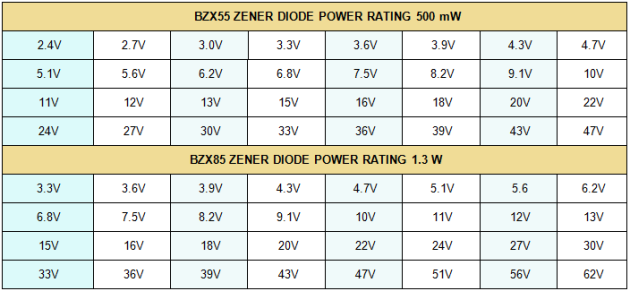DETAILED OPERATION AND CHARACTERISTICS OF ZENER DIODES
The Zener Diode or "Breakdown Diode" as they are sometimes called, are basically the same as the standard PN junction diode but are specially designed to have a low pre-determined Reverse Breakdown Voltage that takes advantage of this high reverse voltage.
The point at which a Zener diode breaks down or conducts is called the "Zener Voltage" (Vz).
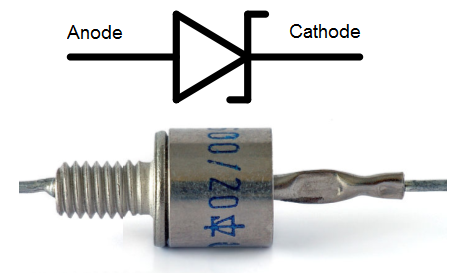
The Zener diode is like a general-purpose signal diode consisting of a silicon PN junction. When biased in the forward direction it behaves just like a normal signal diode passing the rated current, but when a reverse voltage is applied to it the reverse saturation current remains fairly constant over a wide range of voltages.
The reverse voltage increases until the diodes breakdown voltage VB is reached at which point a process called Avalanche Breakdown occurs in the depletion layer and the current flowing through the zener diode increases dramatically to the maximum circuit value (which is usually limited by a series resistor).
The point at which current flows can be very accurately controlled (to less than 1% tolerance) in the doping stage of the diodes construction giving the diode a specific Zener breakdown voltage, (Vz) ranging from a few volts up to a few hundred volts.
8.1. Zener diode characteristics:
This Zener breakdown voltage on the I-V curve is almost a vertical straight line.

The Zener Diode is used in its "reverse bias" or reverse breakdown mode, i.e. the diodes anode connects to the negative supply. From the I-V characteristics curve above, we can see that the Zener diode has a region in its reverse bias characteristics of almost a constant negative voltage regardless of the value of the current flowing through the diode and remains nearly constant even with large changes in current as long as the Zener diodes current remains between the breakdown current IZ(min) and the maximum current rating IZ(max).
This ability to control itself can be used to great effect to regulate or stabilize a voltage source against supply or load variations.
The fact that the voltage across the diode in the breakdown region is almost constant turns out to be an important application of the Zener diode as a voltage regulator.
The function of a regulator is to provide a constant output voltage to a load connected in parallel with it in spite of the ripples in the supply voltage or the variation in the load current and the Zener diode will continue to regulate the voltage until the diodes current falls below the minimum IZ(min) value in the reverse breakdown region.
8.2. The Zener diode regulator:
Zener Diodes can be used to produce a stabilized voltage output with low ripple under varying load current conditions.
By passing a small current through the diode from a voltage source, via a suitable current limiting resistor (RS), the Zener diode will conduct sufficient current to maintain a voltage drop of Vout.
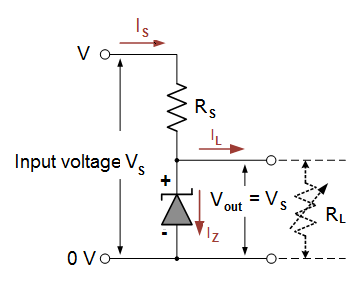
We remember from the previous tutorials that the DC output voltage from the half or full-wave rectifiers contains ripple superimposed onto the DC voltage and that as the load value changes so to does the average output voltage.
By connecting a simple Zener stabilizer circuit as shown below across the output of the rectifier, a more stable output voltage can be produced.
The resistor, RS is connected in series with the Zener diode to limit the current flow through the diode with the voltage source, VS being connected across the combination.
The stabilized output voltage Vout is taken from across the Zener diode. The Zener diode is connected with its cathode terminal connected to the positive rail of the DC supply so it is reverse biased and will be operating in its breakdown condition. Resistor RS is selected so to limit the maximum current flowing in the circuit.
With no load connected to the circuit, the load current will be zero, ( IL = 0 ), and all the circuit current passes through the Zener diode which in turn dissipates its maximum power. Also a small value of the series resistor RS will result in a greater diode current when the load resistance RL is connected and large as this will increase the power dissipation requirement of the diode so care must be taken when selecting the appropriate value of series resistance so that the Zener maximum power rating is not exceeded under this no-load or high-impedance condition.
The load is connected in parallel with the Zener diode, so the voltage across RL is always the same as the Zener voltage, (VR = VZ). There is a minimum Zener current for which the stabilization of the voltage is effective and the Zener current must stay above this value operating under load within its breakdown region at all times.
The upper limit of current is of course dependant upon the power rating of the device. The supply voltage VS must be greater than VZ.
One small problem with Zener diode stabilizer circuits is that the diode can sometimes generate electrical noise on top of the DC supply as it tries to stabilize the voltage. Normally this is not a problem for most applications but the addition of a large value decoupling capacitor across the Zener output may be required to give additional smoothing.
8.3. Zener diodes connected in series:
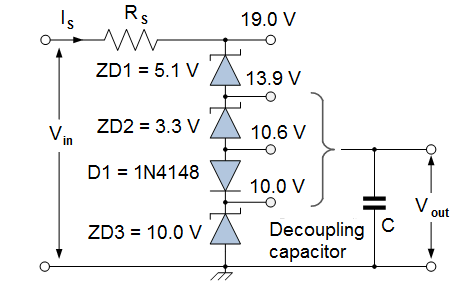
The values of the individual Zener diodes can be chosen to suit the application while the silicon diode will always drop about 0.6 - 0.7V in the forward bias condition. The supply voltage, Vin must of course be higher than the largest output reference voltage and in our example above this is 19v.
A typical Zener diode for general electronic circuits is the 500 mW, BZX55 series or the larger 1.3W, BZX85 series were the Zener voltage is given as, for example, C7V5 for a 7.5 V diode giving a diode reference number of BZX55-C7V5.
The 500mW series of Zener diodes are available from about 2.4 up to about 100 volts and typically have the same sequence of values as used for the 5% (E24) resistor series with the individual voltage ratings for these small but very useful diodes are given in the table below.
8.4. Zener diode standard voltages:
8.5. Zener diode clipping circuits:
Thus far we have looked at how a Zener diode can be used to regulate a constant DC source but what if the input signal was not steady state DC but an alternating AC waveform how would the Zener diode react to a constantly changing signal.
Diode clipping and clamping circuits are circuits that are used to shape or modify an input AC waveform (or any sinusoid) producing a differently shape output waveform depending on the circuit arrangement.
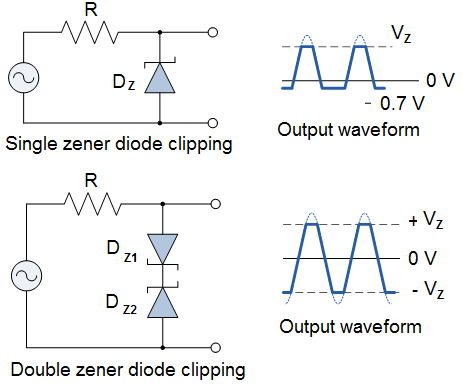
Diode clipper circuits are also called limiters because they limit or clip-off the positive (or negative) part of an input AC signal.
As Zener clipper circuits limit or cut-off part of the waveform across them, they are mainly used for circuit protection or in waveform shaping circuits. For example, if we wanted to clip an output waveform at + 7.5 V, we would use a 7.5 V Zener diode.
If the output waveform tries to exceed the 7.5 V limit, the Zener diode will "clip-off" the excess voltage from the input producing a waveform with a flat top still keeping the output constant at + 7.5 V.
Note 1:
In the forward bias condition a Zener diode is still a diode and when the AC waveform output goes negative below - 0.7 V, the Zener diode turns "ON" like any normal silicon diode would and clips the output at - 0.7 V as shown in figure.
The back to back connected Zener diodes can be used as an AC regulator producing what is jokingly called a "poor man's square wave generator". Using this arrangement we can clip the waveform between a positive value of +8.2 V and a negative value of - 8.2 V for a 7.5 V Zener diode. If we wanted to clip an output waveform between different minimum and maximum values for example, + 8 V and – 6 V, use would simply use two differently rated Zener diodes.
Note 2:
The output will actually clip the AC waveform between + 8.7 V and - 6.7 V due to the addition of the forward biasing diode voltage, which adds another 0.7 V voltage drop to it.
This type of clipper configuration is fairly common for protecting an electronic circuit from over voltage.
The two Zeners are generally placed across the power supply input terminals and during normal operation, one of the Zener diodes is "OFF" and the diodes have little or no affect. However, if the input voltage waveform exceeds its limit, then the Zener turn "ON" and clip the input to protect the circuit.
